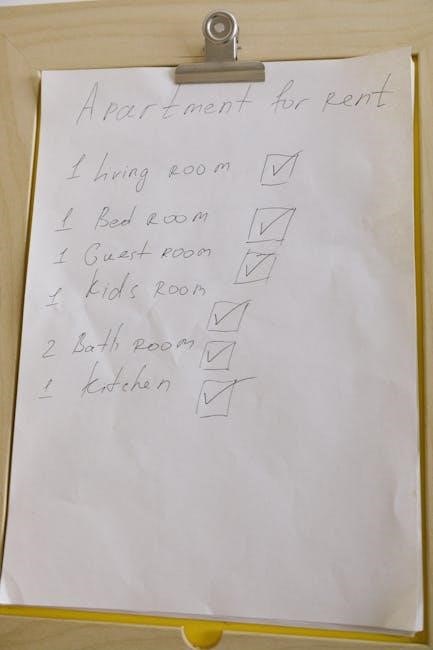A Rent-to-Own Lease Agreement is a legal contract between a landlord and tenant, offering the option to purchase the property during or after the rental period.
Definition and Purpose
A Rent-to-Own Lease Agreement is a hybrid contract combining elements of a rental agreement and a purchase option. It allows tenants to rent a property with the exclusive right to buy it during or at the end of the lease term. This arrangement benefits tenants who cannot immediately secure financing for a purchase or need time to improve their financial standing. For landlords, it provides a steady income stream while potentially resulting in a sale. The agreement outlines rental terms, purchase options, and responsibilities, ensuring clarity and legal protection for both parties. Its purpose is to bridge the gap between renting and homeownership, offering flexibility and mutual benefits.
Benefits for Tenants and Landlords
Tenants benefit from Rent-to-Own agreements as they offer a pathway to homeownership without immediate financial strain. A portion of the rent often applies as a credit toward the purchase price, helping tenants build equity over time. This arrangement also provides stability, as tenants can live in the property while improving their financial standing or securing a mortgage. For landlords, it attracts motivated tenants who are more likely to maintain the property and pursue purchase. It also guarantees consistent rental income and reduces vacancy risks. Both parties gain flexibility and mutual incentives, making it a win-win arrangement for those seeking a balanced rental and ownership transition. This structure aligns the interests of both tenant and landlord, fostering a beneficial partnership.

Structure of a Rent-to-Own Lease Agreement
A Rent-to-Own Lease Agreement outlines property details, lease duration, rent terms, and purchase options, ensuring clarity and mutual understanding between tenant and landlord.
Parties Involved
The primary parties in a Rent-to-Own Lease Agreement are the landlord (seller) and the tenant (buyer). The landlord owns the property and agrees to lease it, while the tenant rents it with the intent to purchase. Both parties must sign the agreement, ensuring mutual understanding of terms. The landlord is responsible for property maintenance and legal compliance, while the tenant must adhere to rental payments and purchase option terms. Additional parties, such as legal counsel or real estate agents, may assist in drafting or reviewing the agreement. This structure ensures clarity and protection for both sides, making the transaction legally binding and transparent.
Term of the Agreement
The term of a Rent-to-Own Lease Agreement specifies the duration of the rental period and the timeframe for exercising the purchase option. Typically, agreements range from 1 to 5 years, providing tenants with sufficient time to improve their financial standing or secure financing. The lease term is clearly outlined, stating the start and end dates, and whether it operates on a fixed or month-to-month basis after the initial period. The option to purchase must be exercised within the specified term, after which it may expire. This structured timeline ensures both parties are aware of their obligations and the expected progression toward potential ownership.
Rent and Payment Terms
Rent and payment terms in a Rent-to-Own Lease Agreement detail the monthly rental amount, due dates, and acceptable payment methods. A portion of the rent, known as a rent credit, may be applied toward the purchase price if the tenant exercises the option to buy. The agreement specifies whether rent credits are fixed or a percentage of the monthly payment. Late payment fees and penalties for missed payments are also outlined to ensure timely obligations. These terms are crucial for maintaining a clear financial understanding between the landlord and tenant, fostering a mutually beneficial arrangement throughout the lease duration.
Option to Purchase
The option to purchase is a core component of Rent-to-Own Lease Agreements, granting tenants the exclusive right to buy the property during or at the end of the lease term. This clause outlines the agreed-upon purchase price, which may be fixed or determined at a future date. Tenants typically pay a non-refundable option fee, which can be applied to the down payment. The agreement specifies the duration of the option and any conditions that must be met, such as maintaining timely rent payments. This provision provides tenants with a clear path to homeownership while ensuring landlords have a committed tenant during the lease period. It balances both parties’ interests effectively.
Security Deposit and Fees
The security deposit and associated fees are critical components of a Rent-to-Own Lease Agreement. The security deposit, typically refundable at the end of the lease, is held to cover potential damages or unpaid rent. Additional fees may include an option fee for the right to purchase the property, which is often non-refundable. Some agreements also specify that a portion of the monthly rent is applied as a rent credit toward the purchase price. These terms are negotiated upfront and outlined in the agreement to ensure clarity for both parties. Proper documentation of these financial terms is essential to avoid disputes and ensure a smooth transaction. Both parties must agree on the amounts and conditions surrounding these deposits and fees.

Key Components of the Agreement
A Rent-to-Own Lease Agreement outlines the property description, rental terms, purchase option details, and default clauses, ensuring clarity and legal protection for both tenant and landlord.
Property Description
The property description section in a Rent-to-Own Lease Agreement provides detailed information about the rental property, including its physical address, type (e.g., house, apartment), and key features. It outlines the number of bedrooms, bathrooms, square footage, and any distinctive characteristics, such as a backyard or specific architectural style. This section ensures both parties have a clear understanding of the property being leased. It may also include details about fixtures, appliances, and structural elements. Accurate property description is essential for avoiding disputes and ensuring the agreement aligns with the actual rental premises. Proper documentation of the property’s condition at the start of the tenancy is also typically included to protect both tenant and landlord interests.
Rental Terms and Conditions
The rental terms and conditions in a Rent-to-Own Lease Agreement outline the responsibilities and obligations of both the tenant and landlord. This section specifies the monthly rent amount, payment due dates, and acceptable payment methods. It also details late payment fees and penalties for non-compliance. Additionally, it covers the tenant’s responsibilities, such as maintaining the property, paying utilities, and obtaining necessary insurance. The agreement may include clauses regarding property use restrictions, subletting, and modifications to the premises. Both parties must adhere to these terms to ensure a smooth rental process and protect their respective interests. Compliance with these conditions is essential for maintaining the validity of the agreement and the option to purchase the property in the future;
Purchase Option Details
The purchase option details in a Rent-to-Own Lease Agreement specify the terms under which the tenant can buy the property. This includes the predetermined purchase price, which may be fixed at the start or based on a future appraisal. The agreement also outlines the timeframe during which the tenant can exercise the option to purchase, typically ranging from one to five years. A portion of the monthly rent, known as rent credit, is often applied toward the down payment. The tenant’s rights and the landlord’s obligations regarding the purchase option are clearly defined to ensure both parties understand their commitments and the process for transitioning from renting to ownership.
Default and Termination Clauses
Default and termination clauses in a Rent-to-Own Lease Agreement outline the circumstances under which the agreement can be terminated. If the tenant fails to meet payment obligations or violates the terms, the landlord may issue a notice of default. The tenant typically has a grace period to rectify the issue before termination. If the tenant chooses not to exercise the purchase option or breaches the agreement, the landlord may retain the security deposit and any rent credits as liquidated damages. Similarly, if the landlord defaults on their obligations, the tenant may terminate the agreement and seek remedies. These clauses ensure clarity on the consequences of non-compliance and provide a framework for resolving disputes.
Legal Considerations
Legal considerations ensure compliance with local laws and protect both parties’ rights, requiring clear terms and professional guidance to avoid disputes and ensure enforceability of the agreement.
Required Clauses
A Rent-to-Own Lease Agreement must include essential clauses to ensure clarity and legal enforceability. Key provisions include a detailed property description, outlining the address and condition of the property. The rental terms should specify the monthly payment, due dates, and acceptable payment methods. The option to purchase clause must define the purchase price, option fee, and the timeframe for exercising the option. A security deposit section should detail the amount and conditions for refund. Additionally, default and termination clauses outline the consequences of missed payments or breaches. Finally, the agreement should include a governing law clause, specifying the jurisdiction. Legal counsel is recommended to ensure all clauses are binding and comply with local regulations.
Compliance with Local Laws
Ensuring compliance with local laws is essential for a valid Rent-to-Own Lease Agreement. The agreement must adhere to state and local regulations, including tenant rights, rent control, and disclosure requirements. For instance, some jurisdictions mandate specific clauses regarding security deposits, while others impose restrictions on rent increases. failure to comply may result in legal disputes or invalidation of the contract. Additionally, the agreement should align with local real estate and leasing laws, such as those governing evictions, property inspections, and option-to-purchase terms. Consulting with legal counsel is recommended to ensure the document meets all legal standards and protects both parties’ interests effectively.
Role of Legal Counsel
Legal counsel plays a crucial role in drafting and reviewing a Rent-to-Own Lease Agreement to ensure its enforceability and compliance with local laws. Attorneys can guide both landlords and tenants through complex legal jargon, ensuring that all terms, such as rent payments, purchase options, and termination clauses, are clear and fair. They also help identify potential risks and negotiate terms to protect their clients’ interests. Additionally, legal counsel can facilitate dispute resolution if issues arise during the tenancy or purchase process. Their expertise ensures the agreement is legally sound, preventing future complications and providing peace of mind for both parties involved in the transaction.

Creating a Rent-to-Own Lease Agreement
Creating a Rent-to-Own Lease Agreement involves drafting a clear and formal contract outlining the terms between the landlord and tenant, including rent, purchase options, and legal clauses to ensure enforceability and compliance with local laws. Using a reliable template and consulting legal counsel can streamline the process, ensuring all necessary details are included for a legally binding document that protects both parties’ interests.
Steps to Draft the Agreement
Drafting a Rent-to-Own Lease Agreement involves several key steps to ensure clarity and legal enforceability. First, identify the parties involved, including the landlord and tenant, and clearly describe the property. Next, outline the rental terms, such as the monthly rent, payment due dates, and late fees. Include the option to purchase, specifying the purchase price, rent credits, and the timeframe for exercising the option. Detail any security deposits or additional fees. Negotiate the terms with both parties to ensure mutual agreement. Ensure compliance with local laws and include required clauses, such as termination conditions. Finally, have the agreement reviewed by legal counsel, executed with signatures, and notarized if necessary. Using a professional template can streamline the process and ensure all essential elements are included.
Negotiation of Terms
Negotiation is a critical step in creating a Rent-to-Own Lease Agreement, ensuring both parties reach a mutually beneficial arrangement. Landlords and tenants should discuss and agree on key terms, such as the monthly rent, the portion of rent allocated as a rent credit toward the purchase price, and the timeframe for exercising the purchase option. The purchase price should be clearly defined, whether fixed or based on a future appraisal. Both parties should also negotiate any fees, such as security deposits or late payment charges. Open communication and compromise are essential to ensure all terms align with both the landlord’s financial goals and the tenant’s purchasing aspirations. Legal or real estate professionals can facilitate this process to ensure fairness and clarity for both sides.
Execution and Signing
Execution and signing are the final steps in formalizing a Rent-to-Own Lease Agreement. Both the landlord and tenant must review the document thoroughly before signing. It is advisable for both parties to seek legal counsel to ensure the agreement complies with local laws and protects their interests. Once satisfied, the agreement is signed in the presence of witnesses or a notary public, depending on local requirements. The tenant typically pays a security deposit at this stage. Each party retains a signed copy for their records. Proper execution ensures the agreement is legally binding and enforceable, providing clarity and security for both the landlord and tenant throughout the rental and potential purchase process.

Obtaining a Rent-to-Own Lease Agreement PDF
Access Rent-to-Own Lease Agreement templates online through legal websites or contract platforms. Customize the document to fit your needs and download as a professional PDF.
Templates and Sources
Rent-to-Own Lease Agreement PDF templates are widely available online, offering customizable solutions for landlords and tenants. Websites like eForms, Lawrina, and other legal platforms provide professionally designed templates that cover essential clauses such as rent payments, purchase options, and termination terms. These templates are often free or low-cost and can be easily downloaded in PDF format. Many templates are fillable, allowing users to input specific details tailored to their agreement. Additionally, some platforms offer both Word and PDF versions, ensuring flexibility for customization. Using these templates ensures a legally sound and professional agreement, protecting both parties’ interests effectively. Always review and customize templates to comply with local laws and regulations.
Customization Options
Rent-to-Own Lease Agreement PDF templates offer extensive customization options to suit specific needs. Users can modify clauses related to rent payments, purchase prices, and lease durations. Many templates allow for the inclusion of property descriptions, tenant responsibilities, and purchase option details. Customization ensures the agreement aligns with local laws and reflects the unique terms negotiated by both parties. Templates often include fillable fields for dates, names, and financial details, making it easy to personalize. Additionally, some platforms provide versions in Word or PDF formats, enabling further adjustments. Customization ensures the agreement is tailored to the landlord’s and tenant’s requirements, making it legally binding and fair for both sides.

Best Practices for Using Rent-to-Own Templates
When using Rent-to-Own Lease Agreement PDF templates, ensure the document is clear and formal to prevent disputes. Customize the template to reflect the specific terms agreed upon by both parties, such as rent payments, purchase options, and lease durations. Always consult legal counsel to verify compliance with local laws and regulations. Make sure all clauses are understood by both the landlord and tenant before signing. Using a legally sound template ensures fairness and protects the interests of both parties. Prioritize transparency and accuracy in drafting the agreement to maintain a positive relationship between the landlord and tenant throughout the lease period.